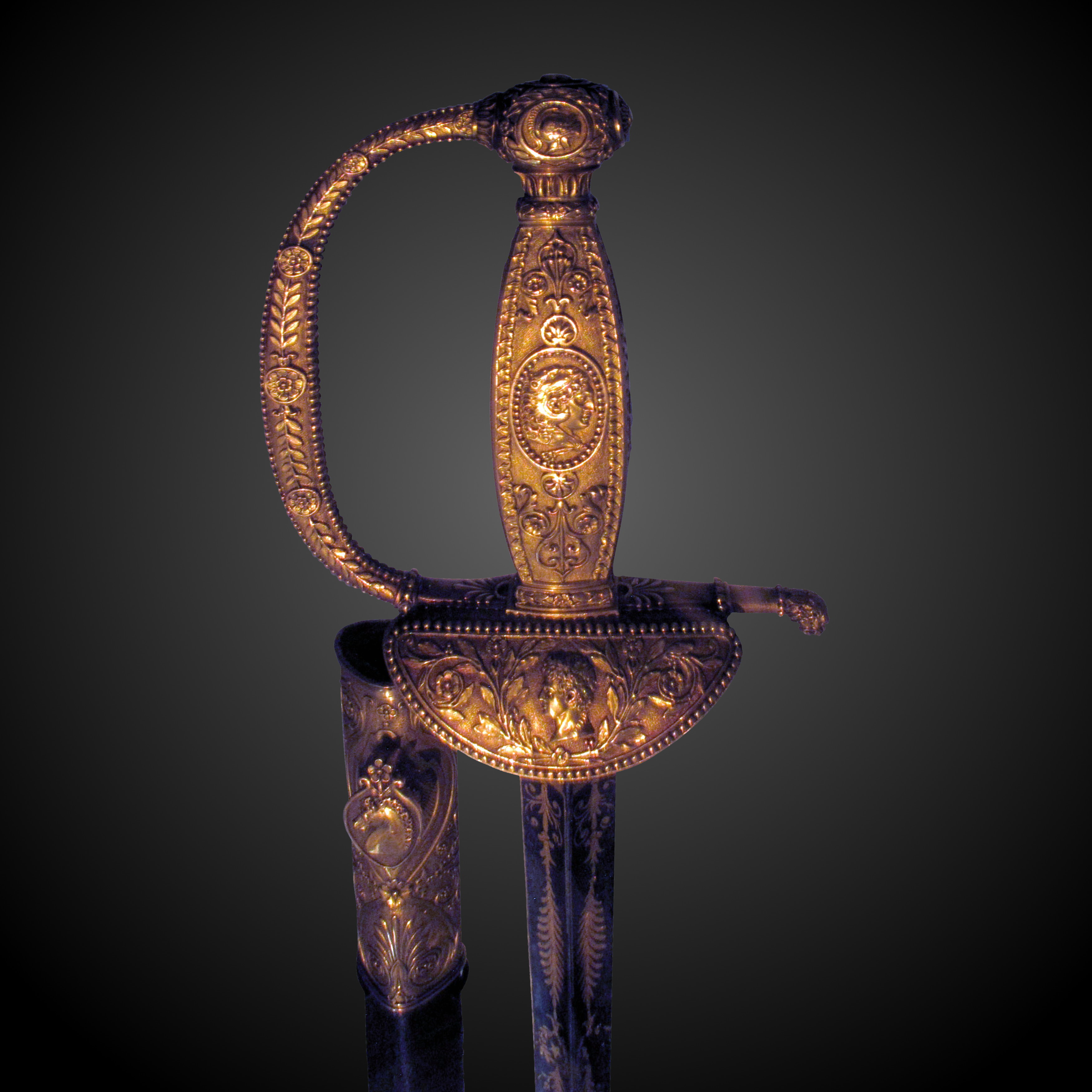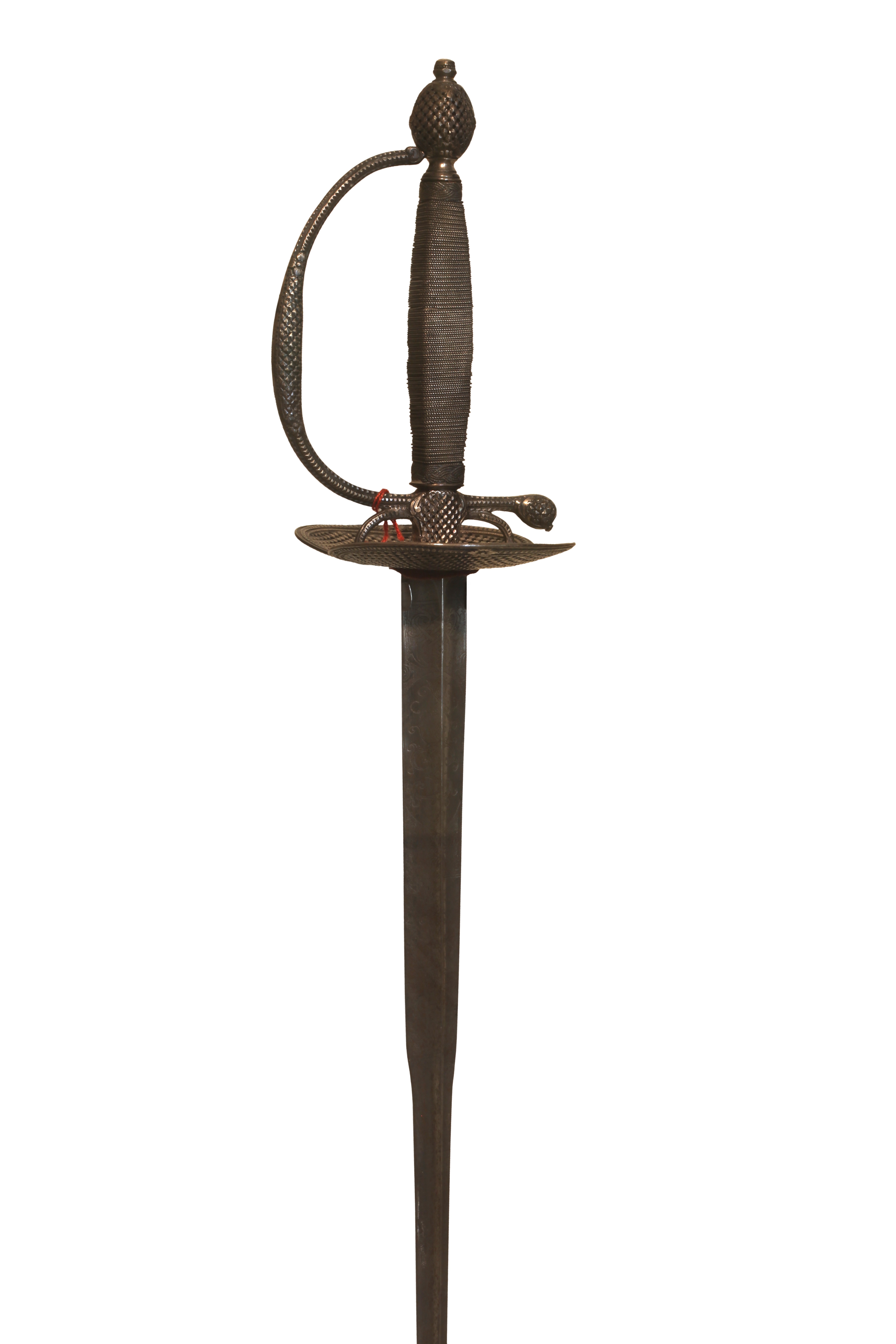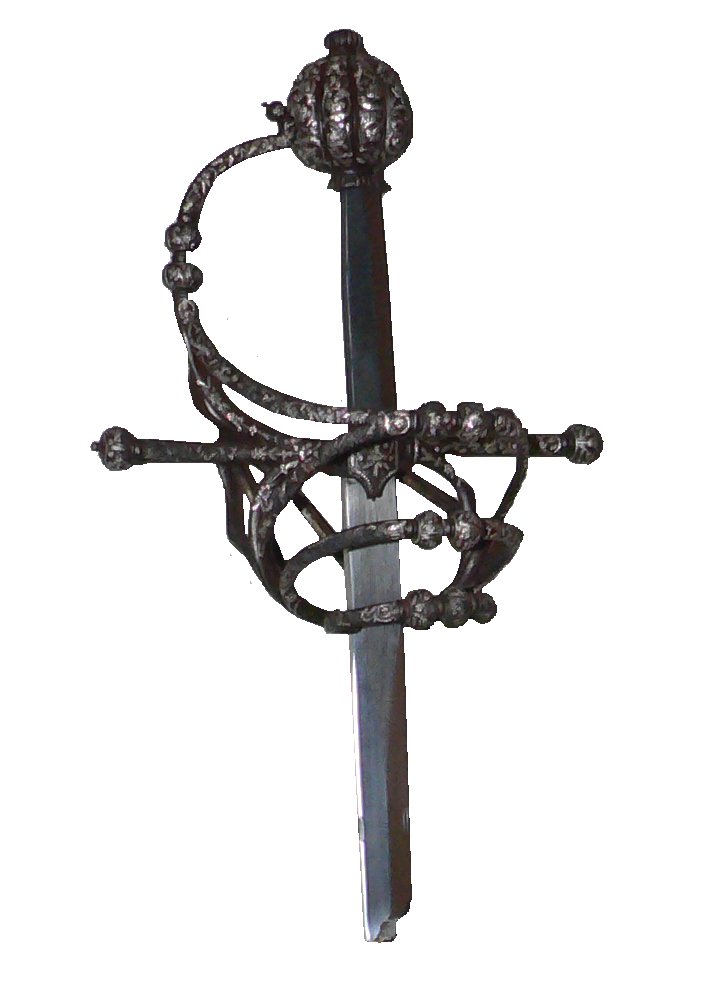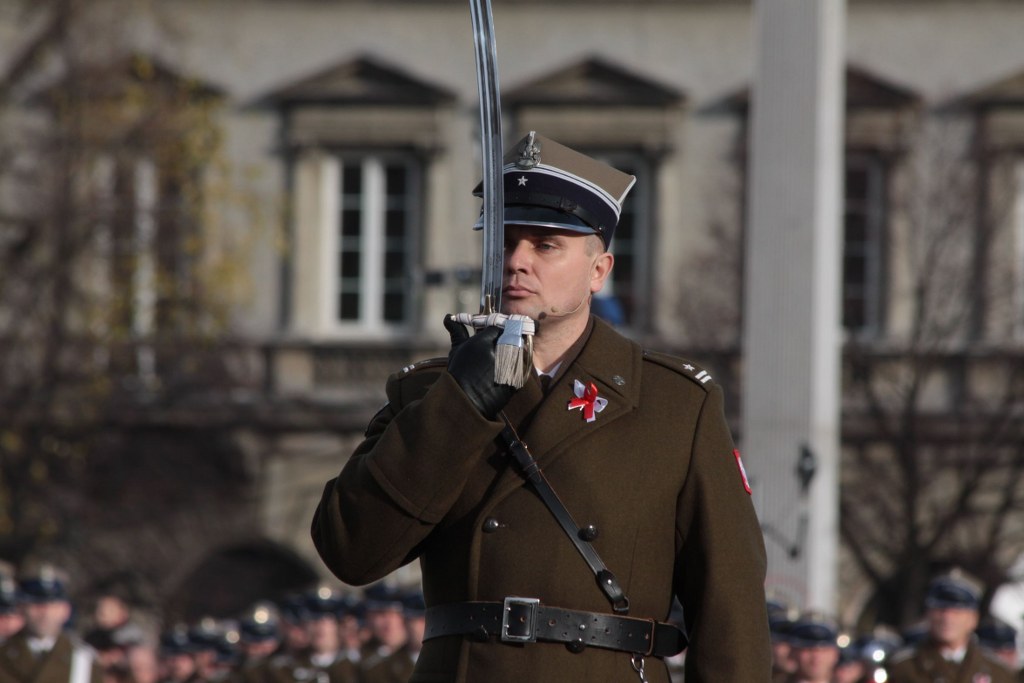|
Smallsword
The small sword or smallsword (also court sword, Gaelic: or claybeg, French: or dress sword) is a light one-handed sword designed for thrusting which evolved out of the longer and heavier rapier of the late Renaissance. The height of the small sword's popularity was between mid 17th and late 18th century, when any man, civilian or military, with pretensions to gentlemanly status would have worn a small sword on a daily basis. The blade of a small sword is comparatively short at around , though some reach over . It usually tapers to a sharp point but may lack a cutting edge. It is typically triangular in cross-section, although some of the early examples still have the rhombic and spindle-shaped cross-sections inherited from older weapons, like the rapier. This triangular cross-section may be hollow ground for additional lightness. Many small swords of the period between the 17th and 18th centuries were found with colichemarde blades. It is thought to have appeared in France an ... [...More Info...] [...Related Items...] OR: [Wikipedia] [Google] [Baidu] |
Colichemarde
Colichemarde is a type of small sword (often written "smallsword") blade that was popular from the late 17th century to the middle 18th century. Overview The small sword is considered to be a descendant of the "transitional rapier", which itself evolved from the rapier due to the demand for a lighter sword, easier to wear. The shape of a colichemarde blade features a wide forte, which abruptly tapers to a much narrower form at a point varying between a fifth to a third of the blade length from the hilt. The blade cross section was most often triangular and hollow-ground. This configuration combines good parrying characteristics, due to the wide blade forte, with the good maneuverability and thrusting characteristics imparted by the narrow blade foible. Its lighter weight, shorter length and superior balance, compared to the rapier, allowed faster and more accurate movement of the blade. This enabled the fencer to achieve a more precisely targeted thrust on an adversary. The ... [...More Info...] [...Related Items...] OR: [Wikipedia] [Google] [Baidu] |
Sword
A sword is an edged, bladed weapon intended for manual cutting or thrusting. Its blade, longer than a knife or dagger, is attached to a hilt and can be straight or curved. A thrusting sword tends to have a straighter blade with a pointed tip. A slashing sword is more likely to be curved and to have a sharpened cutting edge on one or both sides of the blade. Many swords are designed for both thrusting and slashing. The precise definition of a sword varies by historical epoch and geographic region. Historically, the sword developed in the Bronze Age, evolving from the dagger; the earliest specimens date to about 1600 BC. The later Iron Age sword remained fairly short and without a crossguard. The spatha, as it developed in the Late Roman army, became the predecessor of the European sword of the Middle Ages, at first adopted as the Migration Period sword, and only in the High Middle Ages, developed into the classical arming sword with crossguard. The word '' sword'' con ... [...More Info...] [...Related Items...] OR: [Wikipedia] [Google] [Baidu] |
Knuckle-bow
The hilt (rarely called a haft or shaft) of a knife, dagger, sword, or bayonet is its handle, consisting of a guard, grip and pommel. The guard may contain a crossguard or quillons. A tassel or sword knot may be attached to the guard or pommel. Pommel The pommel ( Anglo-Norman "little apple") is an enlarged fitting at the top of the handle. They were originally developed to prevent the sword from slipping from the hand. From around the 11th century in Europe they became heavy enough to be a counterweight to the blade. This gave the sword a point of balance not too far from the hilt allowing a more fluid fighting style. Depending on sword design and swordsmanship style, the pommel may also be used to strike the opponent (e.g., using the Mordhau technique). Pommels have appeared in a wide variety of shapes, including oblate spheroids, crescents, disks, wheels, and animal or bird heads. They are often engraved or inlayed with various designs and occasionally gilt a ... [...More Info...] [...Related Items...] OR: [Wikipedia] [Google] [Baidu] |
Hilt
The hilt (rarely called a haft or shaft) of a knife, dagger, sword, or bayonet is its handle, consisting of a guard, grip and pommel. The guard may contain a crossguard or quillons. A tassel or sword knot may be attached to the guard or pommel. Pommel The pommel ( Anglo-Norman "little apple") is an enlarged fitting at the top of the handle. They were originally developed to prevent the sword from slipping from the hand. From around the 11th century in Europe they became heavy enough to be a counterweight to the blade. This gave the sword a point of balance not too far from the hilt allowing a more fluid fighting style. Depending on sword design and swordsmanship style, the pommel may also be used to strike the opponent (e.g., using the Mordhau technique). Pommels have appeared in a wide variety of shapes, including oblate spheroids, crescents, disks, wheels, and animal or bird heads. They are often engraved or inlayed with various designs and occasionally gilt and ... [...More Info...] [...Related Items...] OR: [Wikipedia] [Google] [Baidu] |
Napoleon Austerlitz Sword-IMG 0648-gradient
Napoleon Bonaparte ; it, Napoleone Bonaparte, ; co, Napulione Buonaparte. (born Napoleone Buonaparte; 15 August 1769 – 5 May 1821), later known by his regnal name Napoleon I, was a French military commander and political leader who rose to prominence during the French Revolution and led successful campaigns during the Revolutionary Wars. He was the ''de facto'' leader of the French Republic as First Consul from 1799 to 1804, then Emperor of the French from 1804 until 1814 and again in 1815. Napoleon's political and cultural legacy endures to this day, as a highly celebrated and controversial leader. He initiated many liberal reforms that have persisted in society, and is considered one of the greatest military commanders in history. His wars and campaigns are studied by militaries all over the world. Between three and six million civilians and soldiers perished in what became known as the Napoleonic Wars. Napoleon was born on the island of Corsica, not long after ... [...More Info...] [...Related Items...] OR: [Wikipedia] [Google] [Baidu] |
Hamburg
Hamburg (, ; nds, label=Hamburg German, Low Saxon, Hamborg ), officially the Free and Hanseatic City of Hamburg (german: Freie und Hansestadt Hamburg; nds, label=Low Saxon, Friee un Hansestadt Hamborg),. is the List of cities in Germany by population, second-largest city in Germany after Berlin, as well as the overall List of cities in the European Union by population within city limits, 7th largest city and largest non-capital city in the European Union with a population of over 1.85 million. Hamburg's urban area has a population of around 2.5 million and is part of the Hamburg Metropolitan Region, which has a population of over 5.1 million people in total. The city lies on the River Elbe and two of its tributaries, the River Alster and the Bille (Elbe), River Bille. One of Germany's 16 States of Germany, federated states, Hamburg is surrounded by Schleswig-Holstein to the north and Lower Saxony to the south. The official name reflects History of Hamburg, Hamburg's history ... [...More Info...] [...Related Items...] OR: [Wikipedia] [Google] [Baidu] |
Court Uniform And Dress In The United Kingdom
Court uniform and dress were required to be worn by those in attendance at the royal court in the 19th and early 20th centuries. Specifically, ''court uniform'' was worn by those holding particular offices associated with the government, the Civil Service, the Royal Household, or similar national institutions. A range of office-holders were entitled to wear it, with different grades of uniform specified for different grades of official. It is still worn today on state occasions by certain dignitaries both in the UK and abroad.Mansfield, Alan, ''Ceremonial Costume''. London: A & C Black, 1980 ''Court dress'', on the other hand, is a stylized form of clothing deriving from fashionable eighteenth-century wear, which was directed to be worn at court by those not entitled to a court uniform. For men, it comprised a matching tailcoat and waistcoat, breeches and stockings, lace cuffs and Cravat, cocked hat and a sword. For women, a white or cream evening gown was to be worn, togeth ... [...More Info...] [...Related Items...] OR: [Wikipedia] [Google] [Baidu] |
René Ribière
René Ribière (1922–1998) was a French politician. He took part in the last ever duel in France in 1967 and lost when he was lightly injured by Gaston Defferre, after Defferre insulted Ribière at the French parliament. Defferre yelled ‘Taisez-vous, abruti!‘ (‘Shut up, stupid!’) at Ribière following an argument in the French National Assembly. Ribière demanded an apology, Defferre refused, so Ribière demanded satisfaction by duel with small sword The small sword or smallsword (also court sword, Gaelic: or claybeg, French: or dress sword) is a light one-handed sword designed for thrusting which evolved out of the longer and heavier rapier of the late Renaissance. The height of the small ...s. René Ribière lost the duel, having been wounded twice. He escaped relatively uninjured, however. References 1922 births French politicians 1998 deaths French duellists {{France-politician-stub ... [...More Info...] [...Related Items...] OR: [Wikipedia] [Google] [Baidu] |
Gaston Defferre
Gaston Defferre (14 September 1910 – 7 May 1986) was a French Socialist politician. He served as mayor of Marseille for 33 years until his death in 1986. He was minister for overseas territories in Guy Mollet’s socialist government in 1956–1957. His main achievement was to establish the framework used to grant independence to France’s African territories. As the Socialist candidate for president in 1969, he received only 5 percent of the vote. He was much more successful in promoting François Mitterrand as leader of the Socialist Party (''Parti Socialiste''; PS) in 1971. He held a series of ministerial portfolios after the Socialist victory in 1981, especially as minister of state for the interior and decentralization. Biography A lawyer and member of the French Section of the Workers' International (SFIO), Defferre was involved in the Brutus Network, a Resistance Socialist group, during World War II. A long-standing member of the National Assembly (1945–1958, 1962 ... [...More Info...] [...Related Items...] OR: [Wikipedia] [Google] [Baidu] |
United States Army
The United States Army (USA) is the land warfare, land military branch, service branch of the United States Armed Forces. It is one of the eight Uniformed services of the United States, U.S. uniformed services, and is designated as the Army of the United States in the United States Constitution, U.S. Constitution.Article II, section 2, clause 1 of the United States Constitution (1789). See alsTitle 10, Subtitle B, Chapter 301, Section 3001 The oldest and most senior branch of the U.S. military in order of precedence, the modern U.S. Army has its roots in the Continental Army, which was formed 14 June 1775 to fight the American Revolutionary War (1775–1783)—before the United States was established as a country. After the Revolutionary War, the Congress of the Confederation created the United States Army on 3 June 1784 to replace the disbanded Continental Army.Library of CongressJournals of the Continental Congress, Volume 27/ref> The United States Army considers itself to be ... [...More Info...] [...Related Items...] OR: [Wikipedia] [Google] [Baidu] |
Ceremonial Weapon
A ceremonial weapon is an object used for ceremonial purposes to display power or authority. They are often used in parades and as part of dress uniforms. Although they are descended from weapons used in actual combat, they are not normally used as such. Their form and, especially, their finishing and decoration are typically designed to show status and power and to be an impressive sight, rather than for practicality as a weapon. Quite often, ceremonial weapons are constructed with precious metals or other materials that make them too delicate for combat use. With ceremonial swords, an example of this is that the sword may be poorly balanced. Historically, however, many ceremonial weapons were also capable of actual combat, most notably in the military. Maces, halberds, daggers and swords are the most common form of ceremonial weapons, but in theory almost any weapon can become ceremonial. The Sergeant at Arms in some parliaments carries a ceremonial mace. The Swiss Guard in th ... [...More Info...] [...Related Items...] OR: [Wikipedia] [Google] [Baidu] |







